Posted by · Leave a Comment
Come along with Tracy Toth, our host, as we visit Wholesome Dairy Farms to learn about raw milk production and the Ayrshire heritage breed of dairy cattle.
Posted by · Leave a Comment
Come along with Tracy Toth, our host, as we visit Wholesome Dairy Farms to learn about raw milk production and the Ayrshire heritage breed of dairy cattle.
Posted by · 1 Comment
Tracy Toth, our host, continues our day at the fair. We learn more of “all things Ag” at the Oley Valley Community Fair in part two of our two-part webisode.
Posted by · Leave a Comment
Six years ago we were hurriedly looking at properties in the area and happened to be with a real estate agent driving right by the Oley Community Fair, which was in full swing.
Parked cars filled every available street spot while large fields and temporary lots accommodated the overflow.
I said something to the agent like, ‘wow, look; a county fair!’ She said that it wasn’t—that it was the “community fair.” That, although it’s open for the public to attend, only residents whose townships join the ag-rich Oley Valley could participate in the contests/judging.
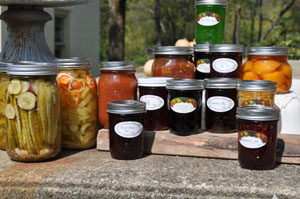
Canning Competition Entries
And, oh, what a level of participation! From the numerous volunteer committee heads and organizers who work year-round for the three-day culmination, to the local fire department, to the thousands who turn out, the excitement and anticipation seems to increase with each year’s festivities.
My friends and I will joke with one another about the “blue ribbons” but, kidding aside, it’s not about that at all. It’s about the celebration of a lifestyle and a heritage that we strive to keep alive. It’s a three-day celebration of a well-connected community… connected with each other and connected to this valley.
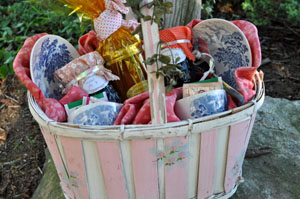
Best Display of Jellies
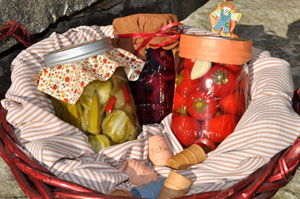
Best Display of Pickles
This is probably a good time to thank Evelyn (again); she was our real estate agent who suggested we might be happy here.
Posted by · 3 Comments
Join our host, Tracy Toth, as she introduces us to a communal celebration of “all things Ag” at the Community Fair in part one of this two-part webisode.
Posted by · 1 Comment
Rebecca Gunther of Jersey West Farm provides more tips about show ring sheep wrangling in part two of our program.
Posted by · Leave a Comment
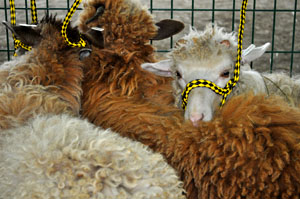 Rebecca Gunther, of Jersey West Farm had been e-mailing me weeks ahead of the Garden State Sheep Festival to, well, beg me to show some of my Navajo-Churro. (That Sunday, there was to be a Navajo-Churro competition and the judge would be none other than Ingrid Painter—decades-long breeder and N-C gal extraordinaire.) Was she kidding??? Me?? Show a sheep?? And in front of Ingrid Painter? NO WAY. I had been curious for years about exhibiting an animal in the show ring—but was just too ignorant to attempt it. After all, where would I start?
Rebecca Gunther, of Jersey West Farm had been e-mailing me weeks ahead of the Garden State Sheep Festival to, well, beg me to show some of my Navajo-Churro. (That Sunday, there was to be a Navajo-Churro competition and the judge would be none other than Ingrid Painter—decades-long breeder and N-C gal extraordinaire.) Was she kidding??? Me?? Show a sheep?? And in front of Ingrid Painter? NO WAY. I had been curious for years about exhibiting an animal in the show ring—but was just too ignorant to attempt it. After all, where would I start?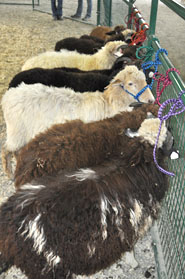
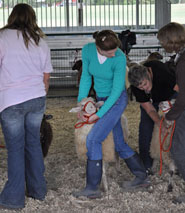
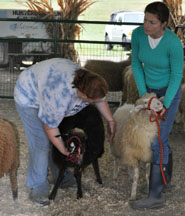 I was bound and determined NOT to let Oneida show ME up in the ring (after all, Ingrid was there!) so I kept her at my side with no slack in the lead and a hand firmly on the back of her neck and another cupping her jaw. Imagine my dismay, after Ingrid’s first few passes, when she asked me to move to one end of the line with Oneida. I had watched a few judgings before this and knew that the end where she was moving me was not where the winners had been repositioned. I probably had “rookie” stamped on my forehead! As beautiful and deserving as Oneida was, I was convinced I had done something as a handler to disqualify us. I was pretty sad.
I was bound and determined NOT to let Oneida show ME up in the ring (after all, Ingrid was there!) so I kept her at my side with no slack in the lead and a hand firmly on the back of her neck and another cupping her jaw. Imagine my dismay, after Ingrid’s first few passes, when she asked me to move to one end of the line with Oneida. I had watched a few judgings before this and knew that the end where she was moving me was not where the winners had been repositioned. I probably had “rookie” stamped on my forehead! As beautiful and deserving as Oneida was, I was convinced I had done something as a handler to disqualify us. I was pretty sad.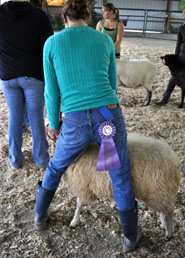
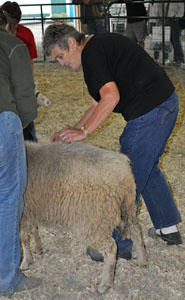 Not only was this rookie wrong about the line-up, Oneida captured a blue-ribbon for her class and we went on to grab the Grand Reserve ribbon!! I couldn’t believe it! Well, it wasn’t “we” after all. Oneida is a one-of-a-kind Navajo-Churro and Ingrid validated that. However, I’d like to think my grip on that little girl that day ushered our chances right along in the ring.
Not only was this rookie wrong about the line-up, Oneida captured a blue-ribbon for her class and we went on to grab the Grand Reserve ribbon!! I couldn’t believe it! Well, it wasn’t “we” after all. Oneida is a one-of-a-kind Navajo-Churro and Ingrid validated that. However, I’d like to think my grip on that little girl that day ushered our chances right along in the ring.Posted by · 1 Comment
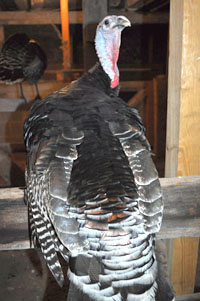
Relaxed Tom
When we began to raise turkeys a few years ago, I had no idea about the “show” they were capable of: the delicate dances, intricate and varietal sounds and calls, and the careful choreography of their mating rituals. Silence does not appear to be in their vocabulary. At any given point during the daylight hours, you can hear the hens and their sharp clucks and the toms gobbling virtually in unison.
Feeding time always brings excitement in the barnyard and the turkeys are no exception—their appearance changes almost instantly!
Unbelievably, the snood (according to the Wild Turkey Federation), which is perched atop the beak, has no known function. It will redden and engorge when the tom is excited and shrink to less than an inch and return to a shade of blue when the tom is relaxed.
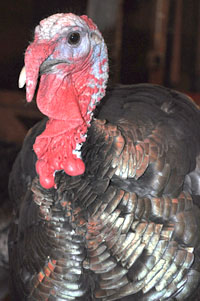
Engorged snood, caruncles and dewlap
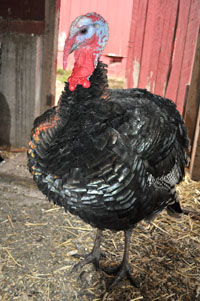
Excited over feeding time
The “caruncles” are bulbous appendages which appear on the neck and head and the dewlap is the skin which connects the underside of the beak to the neck (both sexes). On toms, both of these areas redden and the caruncles will enlarge when strutting or acting aggressively.
Toms possess a somewhat modified feather called a “beard” which protrudes from the center of the breast. It grows three to five inches a year.
As you can imagine, the toms will put on quite the display with their shades of red and magnificent plumage. Do you know when it came time to make the Big Bird costume on TV’s Sesame Street, they reached for white turkey feathers and died them yellow?
The turkey: a natural showstopper!
Posted by · 1 Comment
Our host, Tracy Toth, visits Rebecca Gunther of Jersey West Farm who shares wonderful tips about sheep wrangling in the show ring. We learn a lot about the conformation and characteristics of Navajo-Churro sheep in Webisode 1 of this two part program.
The story continues with Webisode 2, be sure to check it out.
Posted by · Leave a Comment
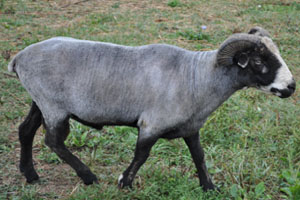
We bred our ewes to Baw Blue (or Blue as he’s commonly called) last year. Reese, our matriarch, “threw” Penny this past Spring.
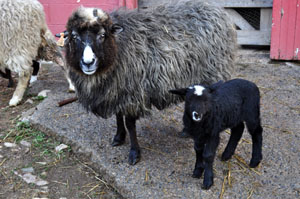
Reese and newborn Penny
Penny was born jet-black except for a little patch of white on her nose, crown, and very faint white “tears” (which I didn’t even notice until it came time to note her markings).
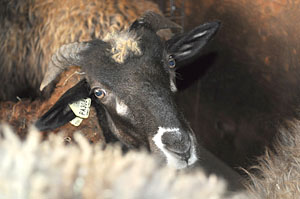
Penny Today
As Penny’s coat grew over the summer, she exhibited signs of black and brown in her wool. The color of churro wool will do that. It can change with age and bleach out with exposure to sunlight. Yet, when the shearer came last week??? What a lovely surprise! As her outer coat fell to the floor, her inner coat was a shimmering light gray-blue against her black legs and under-belly…matched with her distinct “tears” means she’s BLUE. English Blue to be precise.
Blue is the genetic color designation (which does not change) and will be noted on her registry paperwork. Her wool color will change with age and will also be noted on the paperwork — which will accompany a fleece sample from her shearing at one year of age.
[The following “Genetic Color Terms” courtesy of www.navajo-churrosheep.com]
Blue – Born black but in first year develop silver/charcoal inner coat while outer remains brownish/black. May develop white on eyes and muzzle but keep dark points, legs, body and belly are dark. Hips, sides are greyed.
English Blue – Must have white tears, may have white in ears or on muzzle. This is a pattern on Black or Brown.
Texel Blue – Resembles Badgerface. There is a dark bar over each eye, dark top of nose, dark under jaw on light face.
Why is this so special? It’s special because of the rarity of this particular color. The table shows, historically, less than one percent of the population of registered Churro possess this genetic color.
Navajo Churro Color Data – Past and Present
| Color | 1988 | 1998 | Avg. to Date |
| White | 45% | 27% | 34% |
| White/Tan | 4% | 6% | 7% |
| Black | 22% | 40% | 38% |
| Brown | 1% | 18% | 9% |
| Dark Brown | 2% | 2% | 1.7% |
| Grey | 12% | 4% | 4.5% |
| Grey/Tan | 2% | 0% | 0.6% |
| Blue | <1% | <1% | <1% |
| Badgerface | 3% | 10% | 3.6% |
| Black & Tan | 1% | 2% | 1.1% |
| Spots | 3% | 3% | 2.7% |
| Multi | 4% | 1% | 1% |
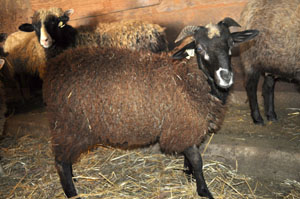
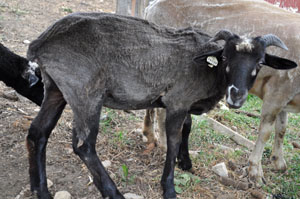
I’m so thrilled to have this color combination in our flock—and to know it’s the matriarch’s ewe-lamb that has it. I can’t wait until Penny’s of “breed-able” age to see how her very special traits are passed on!
Posted by · Leave a Comment
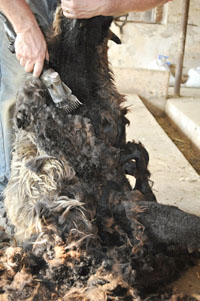 Navajo-Churro sheep need to be shorn twice a year. Their wool grows an inch a month.
Navajo-Churro sheep need to be shorn twice a year. Their wool grows an inch a month.
Typically, we’ll have the shearer come in September and March (or thereabouts). The shearing happens before they’re bred and then again after the lambs arrive. The timing is good in that it cleans the mamas from the lambing and gets them ready for the warmer months.
Our shearer has been doing this his entire life. It’s something I wouldn’t mind trying but it’s such a delicate job, and I love my flock so much, that I’d rather a professional be at the helm of this task.
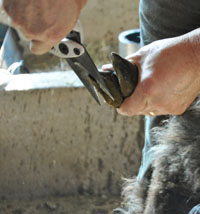 He’ll trim the hooves, de-worm (if we wish) – which just means he administers a “drench,” that is a liquid – and shear.
He’ll trim the hooves, de-worm (if we wish) – which just means he administers a “drench,” that is a liquid – and shear.
His technique is one that many spinners like because he doesn’t take “second cuts.” He takes one long pass along the sheep instead of going back to cut again (resulting in smaller “bits” of wool left in the fleece).
Another good thing about having him do the shearing is that he’s an “outsider” to our flock – he’s a valuable objective observer as to the overall health and well-being of everyone.
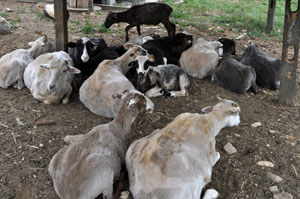 Sheep almost look like different animals after a shearing. It just has to feel good to have that “haircut” every six months or so – just look at how relaxed they all looked that next morning.
Sheep almost look like different animals after a shearing. It just has to feel good to have that “haircut” every six months or so – just look at how relaxed they all looked that next morning.